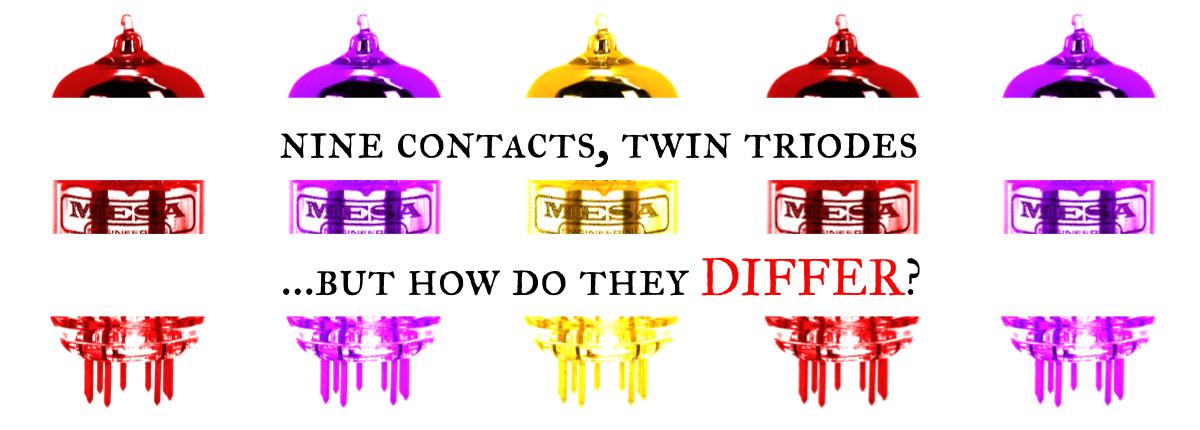
By Ed Malaker
Posted 06/08/2018
The 12AX7, 12AT7, and 12AU7 all belong to the same family of nine contact, twin triode tubes. In many cases, these tubes are interchangeable and can easily be swapped. We will take a look at why you might, or might not, want to swap out these different types of tubes.
The 12AX7
The 12AX7 is by far the best-known preamp tube among guitar players. It has a gain output of 100, making it perfect for the preamp stage of an amplifier, allowing it to drive the power section harder, and enabling it to reach high levels of overdrive and distortion. The 12AX7 is used in many audio preamps and in guitar effects pedals, and it comes in many different versions and brands. The 5751 is a common military-grade substitute for the 12AX7, with a lower gain output of 70.
The 12AT7
The 12AT7 is another very well-known tube among guitar players. It has a much lower gain output at 60, but what you lose in gain you get back with more headroom, higher fidelity, and an increased current output. Because of their high fidelity, they are also used in many tube microphone preamps, compressors, recording equipment, and organs. Because of the higher current, you sometimes see them driving effects such as tube-driven spring reverb in many guitar amps. Like the 12AX7, the 12AT7 has many different variations of this model created with certain specifications in mind, such as low noise or a more “rugged” sound. The 5965 is a common version of the 12AT7 that has a lower output gain of 47.
The 12AU7
The 12AU7 has the lowest gain of these three, with an amplification factor of 20. This is used much less as a preamp tube and more often as a driver for spring reverb. The 12AU7 is also used quite often in the “phase inverter” position of the amplifier, because of the high fidelity and great headroom that it provides. The 12AU7 is featured in many hi-fi audio systems and recording equipment; the current from the tube is enough to drive a pair of headphones or a guitar speaker. Because of this, it is used in many different headphone amps, several small one-tube guitar amplifiers, and in many home hobby projects. Similarly to the 12AT7, the 12AU7 is also heavily used in all stages of organs, and has many different kinds of variations.
As you look at each tube, you might notice that as the amount of gain decreases, the amount of current increases. As the gain decreases, the amount of headroom increases, and fidelity is improved. Noise is also reduced with lower gain tubes.
You can usually swap out 12AX7 tubes with 12AT7 tubes if you want a cleaner guitar tone with more headroom, and don’t mind a drop in volume. This might be helpful for a jazz guitar player, and could also be helpful for using keyboards, vocals, and any other instrument with a lot of high frequencies that you don’t want distorted. The 12AU7 makes a less ideal swap for the 12AX7, because other factors such as bias come into play, and the mismatch can cause the tube to sound unpredictable and very quiet. You may need to look into your guitar wiring to get the proper resistance load necessary to use a 12AU7 in place of a 12AX7.
After being used for over 60 years, there are now dozens of varieties of each of these tubes, and the sound of each will change over the course of its lifespan. One of the most fun aspects of tube amps is the never-ending quest for the perfect tone — that perfect tube. I encourage you to try out as many tubes as you can and to listen to the subtle differences, even in the same type of tubes, as this will inform you in ways that words and even sound samples cannot.
If there are several tubes in the preamp section of your amplifier, the first one will always be the one that has the largest impact on your sound, so start there. This will usually be a 12AX7, but you can swap it for a 12AT7. Next, check your PI tube (in push-pull type amplifiers) and try a 12AU7 or a 12AT7 and see if you prefer the results to a 12AX7 tube. Next, if you have tube-driven effects on your amp, try a 12AU7 or a 12AT7 and see if you prefer the results to a 12AX7 tube in this part of the amp. Now you can think about any other tubes between the first one and the PI. Just keep experimenting until you have YOUR sound, and…
Happy Hunting!
